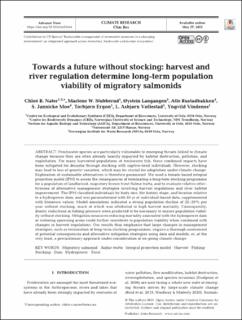| dc.contributor.author | Nater, Chloe Rebecca | |
| dc.contributor.author | Stubberud, Marlene Wæge | |
| dc.contributor.author | Langangen, Øystein Ole Gahr | |
| dc.contributor.author | Rustadbakken, Atle | |
| dc.contributor.author | Moe, S. Jannicke | |
| dc.contributor.author | Ergon, Torbjørn | |
| dc.contributor.author | Vøllestad, Leif Asbjørn | |
| dc.contributor.author | Vindenes, Yngvild | |
| dc.date.accessioned | 2021-12-10T12:00:57Z | |
| dc.date.available | 2021-12-10T12:00:57Z | |
| dc.date.created | 2021-11-24T14:01:57Z | |
| dc.date.issued | 2021 | |
| dc.identifier.citation | Climate Research (CR). 2021. | en_US |
| dc.identifier.issn | 0936-577X | |
| dc.identifier.uri | https://hdl.handle.net/11250/2833776 | |
| dc.description.abstract | Freshwater species are particularly vulnerable to emerging threats linked to climate change because they are often already heavily impacted by habitat destruction, pollution, and exploitation. For many harvested populations of freshwater fish, these combined impacts have been mitigated for decades through stocking with captive-bred individuals. However, stocking may lead to loss of genetic variation, which may be crucial for adaptation under climate change. Exploration of sustainable alternatives is therefore paramount. We used a female-based integral projection model (IPM) to assess the consequences of terminating a long-term stocking programme for a population of landlocked, migratory brown trout Salmo trutta, and to evaluate relative effectiveness of alternative management strategies involving harvest regulations and river habitat improvement. The IPM classified individuals by body size, life history stage, and location relative to a hydropower dam, and was parameterised with 50 yr of individual-based data, supplemented with literature values. Model simulations indicated a strong population decline of 22-29% per year without stocking, much of which was attributed to high harvest mortality. Consequently, drastic reductions in fishing pressure were predicted to be necessary to ensure population viability without stocking. Mitigation measures reducing mortality associated with the hydropower dam or restoring spawning areas could further contribute to population viability when combined with changes in harvest regulations. Our results thus emphasise that large changes in management strategies, such as termination of long-term stocking programmes, require a thorough assessment of potential consequences and alternative mitigation strategies using data and models, or, at the very least, a precautionary approach under consideration of on-going climate change. Migratory salmonid · Salmo trutta · Integral projection model · Harvest · Fishing · Stocking · Dam · Hydropower · Trout | en_US |
| dc.language.iso | eng | en_US |
| dc.publisher | Inter Research | en_US |
| dc.rights | Navngivelse 4.0 Internasjonal | * |
| dc.rights.uri | http://creativecommons.org/licenses/by/4.0/deed.no | * |
| dc.title | Towards a future without stocking: harvest and river regulation determine long-term population viability of migratory salmonids | en_US |
| dc.type | Peer reviewed | en_US |
| dc.type | Journal article | en_US |
| dc.description.version | publishedVersion | en_US |
| dc.rights.holder | © The authors 2021 | en_US |
| dc.subject.nsi | VDP::Matematikk og naturvitenskap: 400 | en_US |
| dc.subject.nsi | VDP::Mathematics and natural scienses: 400 | en_US |
| dc.source.pagenumber | 16 | en_US |
| dc.source.journal | Climate Research (CR) | en_US |
| dc.identifier.doi | 10.3354/cr01644 | |
| dc.identifier.cristin | 1958435 | |
| dc.relation.project | Norges forskningsråd: 244647 | en_US |
| cristin.ispublished | true | |
| cristin.fulltext | original | |
| cristin.qualitycode | 1 | |

